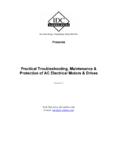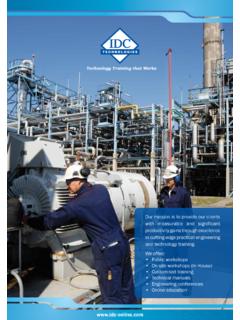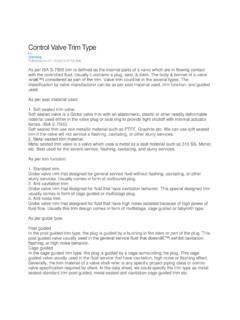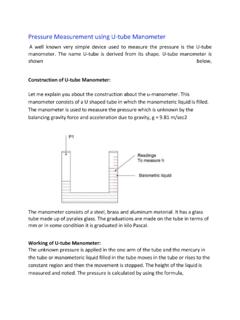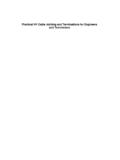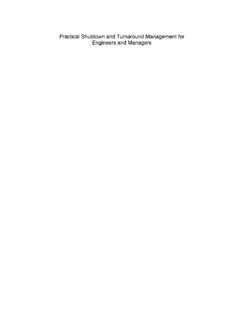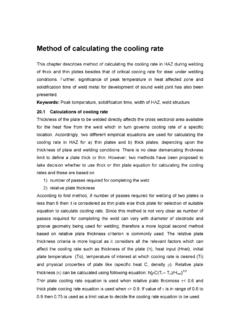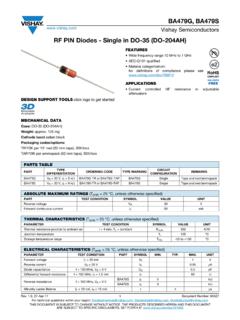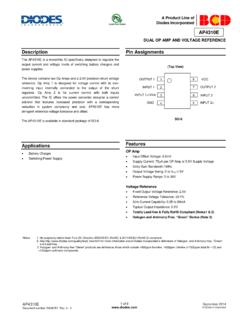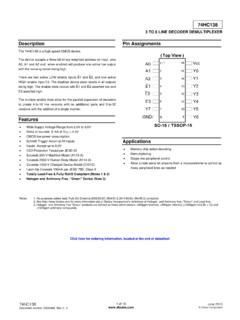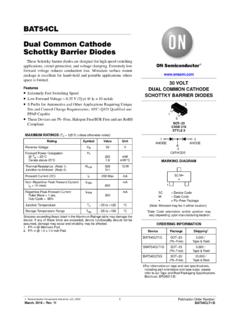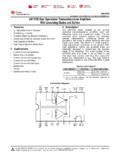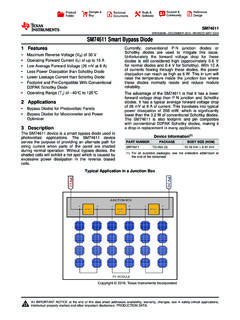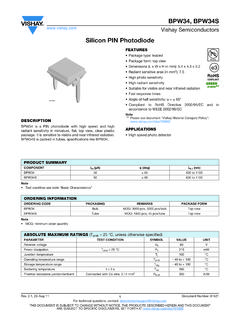Transcription of Basics and Types of Diodes - IDC
1 Basics and Types of Diodes Introduction to diode : A diode is an electric device that permits the flow of current only in one direction and restricts the flow in the opposite direction. The most ordinary sort of diode in current circuit design is the semi-conductor diode , even though additional diode technologies are present. The word diode is traditionally aloof for tiny signal appliances, I 1 A. When a diode is positioned in a simple battery lamp circuit, then the diode will either permit or stop flow of current through the lamp, all this depend on the polarization of the volts applied. There are various sorts of diode but their fundamental role is identical.
2 The most ordinary kind of diode is silicon diode ; it is placed in a glass cylinder. The symbol of diode is represented as follows: diode Operation: A diode starts its operations when a voltage signal applies across its terminals. A DC volt is applied so that diode starts its operation in a circuit and this is known as Biasing. diode is similar to a switch which is one way, hence it can be either in conduction more or non-conduction mode. ON mode of the diode , is attained by forward biasing, which simply means that higher or positive potential is applied on the anode and on the cathode, negative or lower potential is applied of a diode . Whereas the OFF mode of the diode is attained with the aid of reverse biasing which simply means that higher or positive potential is applied on the cathode and on the anode, negative or lower potential is applied of a diode .
3 In the ON situation the practical diode provides forward resistance. A diode needs forward bias voltage to get in the ON . mode this is known as cut-in-voltage. Whereas the diode initiates conducting in reverse biased manner when reverse bias voltage goes beyond its limit and this is known as breakdown voltage. The diode rests in OFF mode when no voltage is applicable across it. Function of diode : The key function of a diode is to obstruct the flow of current in one direction and permit the flow of current in the other direction. Current passing through the diode is known as forward current whereas the current blocked by the diode is known as the reverse current.
4 diode Equation: The equation of diode expresses the current flow via diode as a function of voltage. The ideal diode equation is . Where I Stands for the net current passing through a diode I0 - Stands for dark saturation current, the diode seepage current density in the deficiency of light V Stands for applied voltage across the terminals of the diode q Stands for fixed value of electron charge k Stands for Boltzmann's constant T Stands for fixed temperature (K). diode Circuits: The basic aim behind this study is to show how Diodes can be employed in circuits. Now let us analyze a simple diode circuit. Keep in mind what we learnt about ideal Diodes .
5 Here we are assuming that diode is ideal, this is just for the purpose of discussion. 1. When diode is in ON mode, no voltage is there across it; hence it acts like a short circuit. 2. Whereas when diode is in OFF mode, there is zero current, hence it behaves like an open circuit. 3. From the above two conditions, either one can take place at a time. This helps us to check out what will happen in any circuit with Diodes . diode Characteristics: Diodes have attributes that allow them to carry out a number of electronic functions. Three vital characteristics of Diodes are as follows: Forward Voltage Drop- forward bias about seven volts Reverse Voltage Drop- Weakened layer broadens, generally the applied voltage Reverse breakdown voltage- reverse voltage drop that'll force flow of current and in maximum cases demolish the Diodes .
6 Application of Diodes : Diodes are employed in a variety of applications such as clipper, rectification, clamper, comparator, voltage multiplier, filters, sampling gates, etc. 1. Rectification: Rectification symbolizes the alteration of AC volt into DC volt. Some of the common examples of rectification circuits are- FWR (full wave rectifier), bridge rectifier & HWR (half wave rectifier). 2. Clipper: diode can be employed to trim down some fraction of pulse devoid of deforming the left over fraction of the waveform. 3. Clamper: A clamping circuit limits the level of voltage to go beyond a limit by changing the DC level. The crest to crest is not influenced by clamping.
7 Capacitors, resistors & Diodes all are used to create clamping circuits. Types of Diodes : All sort of Diodes are dissimilar in means of construction, characteristics & applications. Following are some of the Types of Diodes : Small Current diode Large Signal or Large Current Diodes Zener Diodes LED (Light Emitting Diodes ). Photodiodes Constant Current Diodes Schottky diode Shockley diode Step Recovery Diodes Tunnel Diodes Varactor Diodes PIN Diodes LASER diode Transient Voltage Suppression Diodes Gold Doped Diodes Super Barrier Diodes Point Contact Diodes Peltier Diodes Gunn diode Vacuum Diodes Avalanche diode Crystal diode Zener diode : Zener diode works in reverse bias situation when the voltage attains the breakdown peak.
8 An even voltage can be attained by insertion of a resistor across it to limit the flow of current. This Zener diode is employed to give reference voltage in power supplying circuits. Symbol of Zener diode : Zener diode Characteristics: Special Diodes such as zener Diodes are intended & manufactured to function in the opposite direction without being broken. 1. The zener diode acts like a common silicon diode , during the forward bias. 2. Changeable quantity of reverse current can go through the diode devoid of destructing it. The Vz (zener voltage) or breakdown voltage across the diode upholds comparatively steady. 3. Producers rate zener Diodes as per their zener voltage value and the highest PD (Power Dissipation) at 25 C.
9 This provides a signal of the highest IR (reverse current), that a diode securely carries out. Zener diode Applications: Zener Diodes have many applications in transistor circuitry. Here we are discussing various vital points in Zener diode applications: Zener diode Shunt Regulator- This diode is commonly employed as a Voltage Regulator or Shunt Regulator. Meter Protection- This diode may also come across its functions in meter security. Zener diode as Peak Clipper- This Diodes can be employed to cut off the maximum value of incoming waveform. Switching operation- This diode can generate an unexpected alteration from low to high current, so it is functional in switching applications.
10 It is relatively speedy in switching processes. P-N Junction diode : The simplest semi-conductor appliance is named as p-n junction diode . It is a 2 terminal, one-sided, bipolar repairing device that conducts just in 1 direction. The common Diodes are employed in the following areas: Modification in power supplying circuits Mining of modulation from broadcasting signals in a radio recipient and in security circuits where big transient currents may emerge on ICs or low current transistors in interfacing with relays or other soaring power appliances. Employed in series with power inputs to electric circuits where just 1 positive or negative polarity voltage is required.
